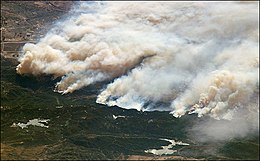
Back علم بيئة الحرائق Arabic Пожарна екология Bulgarian Feuerökologie German Ecología del fuego Spanish بومشناسی آتش Persian Écologie du feu French Ecologia do fogo Portuguese Fire ecology SIMPLE

Fire ecology is a scientific discipline concerned with the effects of fire on natural ecosystems.[1] Many ecosystems, particularly prairie, savanna, chaparral and coniferous forests, have evolved with fire as an essential contributor to habitat vitality and renewal.[2] Many plant species in fire-affected environments use fire to germinate, establish, or to reproduce. Wildfire suppression not only endangers these species, but also the animals that depend upon them.[3]
Wildfire suppression campaigns in the United States have historically molded public opinion to believe that wildfires are harmful to nature. Ecological research has shown, however, that fire is an integral component in the function and biodiversity of many natural habitats, and that the organisms within these communities have adapted to withstand, and even to exploit, natural wildfire. More generally, fire is now regarded as a 'natural disturbance', similar to flooding, windstorms, and landslides, that has driven the evolution of species and controls the characteristics of ecosystems.[4]
Fire suppression, in combination with other human-caused environmental changes, may have resulted in unforeseen consequences for natural ecosystems. Some large wildfires in the United States have been blamed on years of fire suppression and the continuing expansion of people into fire-adapted ecosystems as well as climate change.[5] Land managers are faced with tough questions regarding how to restore a natural fire regime, but allowing wildfires to burn is likely the least expensive and most effective method in many situations.[6]
- ^ Kreider, Mark R.; Jaffe, Melissa R.; Berkey, Julia K.; Parks, Sean A.; Larson, Andrew J. (2023). "The scientific value of fire in wilderness". Fire Ecology. 19 (1): 36. Bibcode:2023FiEco..19a..36K. doi:10.1186/s42408-023-00195-2.
- ^ Dellasala, Dominick A.; Hanson, Chad T. (7 July 2015). The Ecological Importance of Mixed-Severity Fires. Elsevier Science. ISBN 9780128027493.
- ^ Hutto, Richard L. (2008-12-01). "The Ecological Importance of Severe Wildfires: Some Like It Hot". Ecological Applications. 18 (8): 1827–1834. Bibcode:2008EcoAp..18.1827H. doi:10.1890/08-0895.1. ISSN 1939-5582. PMID 19263880.
- ^ The ecology of natural disturbance and patch dynamics. Pickett, Steward T., 1950-, White, P. S. Orlando, Fla.: Academic Press. 1985. ISBN 978-0125545204. OCLC 11134082.
{{cite book}}: CS1 maint: others (link) - ^ Westerling, A. L.; Hidalgo, H. G.; Cayan, D. R.; Swetnam, T. W. (2006-08-18). "Warming and Earlier Spring Increase Western U.S. Forest Wildfire Activity". Science. 313 (5789): 940–943. Bibcode:2006Sci...313..940W. doi:10.1126/science.1128834. ISSN 0036-8075. PMID 16825536.
- ^ Noss, Reed F.; Franklin, Jerry F.; Baker, William L.; Schoennagel, Tania; Moyle, Peter B. (2006-11-01). "Managing fire-prone forests in the western United States". Frontiers in Ecology and the Environment. 4 (9): 481–487. doi:10.1890/1540-9295(2006)4[481:MFFITW]2.0.CO;2. ISSN 1540-9309.
© MMXXIII Rich X Search. We shall prevail. All rights reserved. Rich X Search